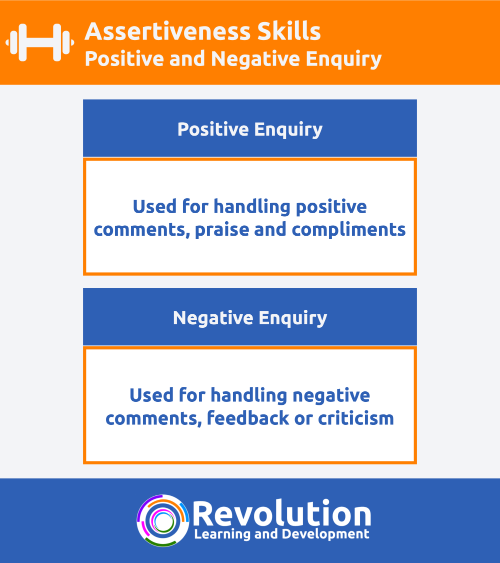Background
The positive and negative enquiry technique is a skill used in assertiveness training. It is used when someone provides us with a compliment or praise or when someone provides us with negative feedback or criticism.
The technique was described by Manuel J. Smith in his book When I Say No, I Feel Guilty. It helps those of us who find it difficult to respond to praise or criticism to respond in an assertive way.
The positive and negative enquiry technique has 2 different responses – positive and negative which are more commonly known as positive enquiry and negative enquiry.
The Positive and Negative Enquiry Technique
Unlike other assertiveness techniques such as fogging or broken record which require us to just acknowledge the praise or the mistakes or errors that we have made, the positive and negative enquiry technique invites more details about the praise or criticism that we have been provided with.
It essentially ‘tests’ the praise or criticism to ensure it is valid and backed up with evidence, rather than being a tactic that is being used to lead us to commit to something or a personal attack.
There are 2 sides to the positive and negative enquiry technique to deal with positive comments or negative comments:
- Positive Enquiry – used for handling positive comments, praise and compliments
- Negative Enquiry – used for handling negative comments, feedback or criticism

Positive Enquiry
The positive side of the positive and negative enquiry technique, known as positive enquiry, is used for handling positive comments, praise and compliments.
Many people struggle with positive feedback or compliments in that they don’t know how to respond. It’s important that when someone gives us a compliment or praise that we investigate (or test) why they are doing this.
This is because this can be a tactic that is used to lead us to a point where we agree to something because we feel we should because the person was nice to us.
When someone compliments us or gives us praise, it’s useful to know the specifics of the compliment or praise so we can continue to do what led to the positive comments. We do this by enquiring or asking for more details. For example:
Other person: “that was a great presentation, I really enjoyed it”
You: “thank you. I felt it went well too. What did you like about it?”
If we were not using positive enquiry or not being assertive, we may just shrug the compliment off and not truly understand what you did so well so that you can continue to do this in future.
As you can see from the example above, we agree with the compliment to show that we heard, then follow up with an open question to find out more details.
Negative Enquiry
The negative side of the positive and negative enquiry technique, known as negative enquiry, is used for handling negative comments, feedback or criticism.
When someone provides us with negative comments, unconstructive feedback or criticism, it can be easy for us to become aggressive or defensive or possibly passive-aggressive. This can damage your relationships with that person and you will never understand what you can do to improve on what they are feeding back on.
Much the same as positive enquiry, using negative enquiry uses a question to ask the person providing the feedback to go into more detail. For example:
Other person: “that presentation wasn’t what I thought it would be, I really didn’t learn much from it”
You: “I didn’t quite go as planned. What did you not like about it?”
As you can see from the example above, we agree with the feedback to show that we heard, then follow up with an open question to find out more details.
Applying the Positive and Negative Enquiry Technique
When using the positive and negative enquiry technique we should:
- Not be defensive or argumentative when responding to negative feedback or criticism
- Not deny the feedback or compliment we are given – remember, this is just their option and that’s why we question it
- Be careful of our tone of voice and body language – we want to come across as sincere and curious rather than sarcastic or insincere
- Thank the person for their comments and feedback, even if it is negative
- Not show that we have dismissed the feedback in any way
Further Learning
To learn more about the positive and negative enquiry technique and other assertiveness tools, take a look at our Assertiveness Training Course for more details.





